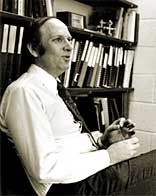 |
| Schrieffer |
Schrieffer's Story
Theorists at work:
How we got an explanation of superconductivity
Excerpts from an interview with J. Robert Schreiffer
Questions by Joan N. Warnow
Q: Bob, everybody knows you were involved in what turned out to be the explanation of superconductivity. How did that come about?
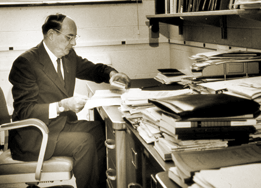 |
| Bardeen |
I recall the second year I was at Urbana, that was '54, '55.... and I had really hoped all the time when I went there that I would get to work on superconductivity....I came and asked Bardeen for a real thesis problem, and I'm sure he had this in mind. And he said, "Come in and see me." Exactly how the discussion came, I don't quite recall, but he traditionally kept in his bottom drawer a list of problems. And I remember there were ten problems on this particular list and the tenth was superconductivity. He said, "Well, why don't you think about it?"
Q: Well, what did you do?
I went and chatted with Francis Low about this, because I felt that I
could chat with him. He was very open. And I asked him what he thought
about it, should I try this? He, I recall, asked, "How old are you?"
and I told him. And he said, "Well, you can waste a year of your life
and see how it goes."
The program really had been
worked out in John's mind, I don't know, ten years before or what have
you....He had this thing so nailed down on every corner: he understood
the experiments, he understood the general requirements of the theory.
The whole thing was more or less jelled in his mind. And then there was
this stumbling block, and that was, you know, how to write down the
wave function.
Q: Now, just where were you located — I mean, physically — at the University?
I was at what was called the "Institute for Retarded Study" — affectionately known — and it was on the third and a half floor of the building... It was again a wonderful format. There were people all together in one large area. There were field theorists, there were nuclear physicists — all theorists came there. And if somehow you were able to move to the Institute for Retarded Study, you had made it. That was considered the greatest. And when there was a place open, a desk open, then everyone would sort of scramble around to see who could get in there.... There was a great blackboard, and there were always two or three people at the blackboard, arguing and discussing. So that was fun. They were all students there.

Q: That seems marvelous! Now — let's see — John Bardeen and Leon Cooper were in the physics building and you were at the "Institute." How did you all interact?
 |
 |
| Bardeen | Cooper |
Bardeen and Cooper shared an office, and that was very important. They could wheel around their chairs and talk to each other continually. But I would come down and say something. to John and then Leon was there and we'd get together into a three way discussion — or if Leon was out, John and I would chat. But it was sort of a round robin where I think John and Leon probably didn't talk too much more than I chatted, but they were always together — and when they had a question, it would come up and they would discuss it. So, that was a very happy relationship which largely came about because there weren't enough offices for everyone. They were just squeezed in.
I'd been working on the Brueckner theory, and Leon took very seriously the energy gap aspect and focussed on that.
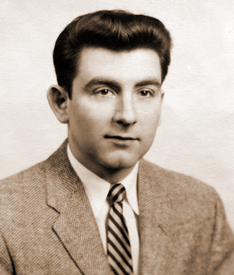 |
| Cooper in 1955 — the picture he sent with his application for a postdoctoral position |
Leon's discovery, that a pair is unstable, suggested a direction we should move to understand which hunk of the Hamiltonian we should look at — which piece of the total interaction was important.... So we started thinking about how we could make a many-body theory which took into account many pairs at the same time....We said, "OK, let's write down the problem where all electrons are treated, but we treat them in the second quantization formalism corresponding to pairs of zero momentum, and try and solve that problem"....And the fact that we concentrated on the pairs of zero momentum, rather than trying to treat all momentum pairs simultaneously, was to a certain extent out of simplicity: do the simplest thing first, if it doesn't work, then go on to the next most complicated. That seemed obvious. But then the problem came, we couldn't even solve that simplest of problems.
We wrote down the Hamiltonian and looked at it and couldn't make any progress on it. We didn't know how to approach it — various ideas about variational methods, we thought — tried all sorts of approximate schemes....It was very exciting, but it was very frustrating, needless to say. And it wasn't clear what was going to happen....We also felt we were really hot. It was sort of this mixed feeling. We were really on the trail, and it was sort of almost a schizophrenia, you know — we're going to do it, and we're not.
Q: You all knew you were looking for a wave function. Am I right?
That's right — in garbage cans and whatever
Q: And this went on for several months?
Yeah.
Q: Weren't you all feeling somewhat discouraged?
I personally had become somewhat discouraged at being able to make significant progress taking Leon's beautiful result and making a many-body theory out of it....I had started to quietly work on ferromagnetism. And I had mentioned to Bardeen that I thought perhaps I would like to change the thesis topic, because I didn't quite see that we were going anywhere.
Q: And what was Bardeen's reaction?
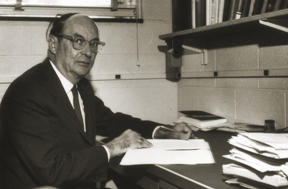 Well,
I remember, just before John left for Stockholm, he said, "Give it
another month or a month and a half, wait 'til I get back, and keep
working, and maybe something will happen and then we can discuss it a
little later."
Well,
I remember, just before John left for Stockholm, he said, "Give it
another month or a month and a half, wait 'til I get back, and keep
working, and maybe something will happen and then we can discuss it a
little later."
In any event, we proceeded on, and then there was this meeting at Stevens and the New York meeting. And that was in the middle to end — I guess the end of January. And, somehow, during that couple of days in New York — whether it was at the Stevens part of it or the APS meeting part, it was some time during that week — I started to think about the variational scheme associated with this Tomonaga wave function....I wanted to use a variational scheme because there didn't seem to be any other scheme that was appropriate. One had to guess the answer, if you like, and then use some sort of a variational approach.
 |
| Schrieffer as a student |
And I said, "Well, lookit, there're so many pairs around, that some sort of a statistical approach would be appropriate." That was sort of floating around in my mind — that there are so many pairs, they're overlapping — some sort of a statistical approach is appropriate. And, then the other one was this Tomonaga wave function — all sort of crystallized in saying, "Well, suppose I put an amplitude," I think I called it the square root of H, "that the state is occupied, and a square root of 1 minus H, that it's unoccupied — the amplitude — and then let's product these over all states k." And that's just what Tomonaga did for that problem. I said, "Well, at least that allows the electrons to hop from — or the pairs to hop from — state to state, and that seemed like a reasonable guess." We were futzing around and that was one try.
So I set that down and then I looked at it, and I realized that that didn't conserve the number of electrons. It was a variable number of electrons and that had worried me, I remember. And so I decided, "Well, what I should do is multiply that wave function by a term involving e to the minus the number of particles and —just like in the grand canonical ensemble in statistical mechanics — sort of extend that idea to the wave function in quantum mechanics." And I said, "Gee, I don't know if it's going to work, but it seems to me a reasonable approach. Let me try it."
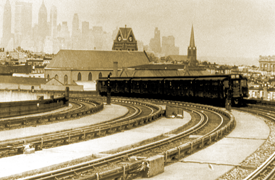 So
I guess it was on the subway, I scribbled down the wave function and I
calculated the beginning of that expectation value and I realized that
the algebra was very simple. I think it was somehow in the
afternoon and that night at this friend's house I worked on it. And the
next morning, as I recall, I did the variational calculation to get the
gap equation and I solved the gap equation for the cutoff potential.
So
I guess it was on the subway, I scribbled down the wave function and I
calculated the beginning of that expectation value and I realized that
the algebra was very simple. I think it was somehow in the
afternoon and that night at this friend's house I worked on it. And the
next morning, as I recall, I did the variational calculation to get the
gap equation and I solved the gap equation for the cutoff potential.
It was just a few hours work. It was really exciting, it was fun. it was sort of beautiful and elegant — things worked out. It was all algebraic and I didn't have to go to a computer, or you know, there weren't terms I just threw away because I just couldn't handle them, but the whole thing was analytic. There were certain beauties, a simplicity, which — you might call it esthetics. I think that's — to my mind, that's a phony word, it implies more than that. But, it was sort of nice and I liked it.
Q: So, now you had it — that wave function. Did you feel that things were falling into place?
The consequences, you know, weren't clear to me or weren't important.
Q: And you were also very young. 25?
Right. I'd seen a certain amount of physics. And I didn't have perspective....I didn't have any basis to judge right or wrong, so I assumed that this was, perhaps not wrong, but it was a beginning of another interesting idea. Like Leon had a very good idea and it worked to a certain extent. I assumed that this was perhaps a good idea and it would move one along, but this wasn't the solution to the problem.
So people keep saying, "Nature is ultimately simple." I guess in some sense it depends upon the eyes. But this was so simple I didn't believe it. And that was sort of the other side.
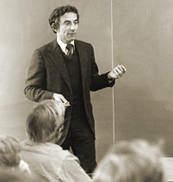 |
| Cooper (ca. 1972) |
It was an intuitive leap. And any intuitive leap, you have to justify it through a lot of tie points to experiment, and ultimately you hope there's a theoretical deductive way of getting there. But it was certainly far from that and I think even today we're not there....But I guess the main point I wanted to make was, I thought it was too simple and this just can't be the answer. It was exciting because it was fun to do, it worked out.
And I met Leon then at the Champaign airport. Apparently he'd come in also from New York. Why we came there — I don't know — at the same time, but we appeared. I showed him this and he seemed very interested. He said, "Great, looks terrific," and "Let's go and talk to John in the morning"....You know, we really worked as a team, and I can't imagine of any more cooperative feeling....So the next morning we went and chatted with Bardeen and very quickly, as I recall, he looked at it and he said he thought that there was something really there.
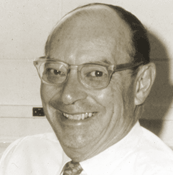 It was so fantastically exciting that we sort of worked 18 hours a day,
because there was just so much to do.... So we were working on two levels.
One was saying, "Isn't it fantastic? It's all breaking open."
But on the other level we were having mechanical difficulties of doing
all the calculations and working and checking, etc. So it was an intensive
period of intellectual activity, but also just hard work.
It was so fantastically exciting that we sort of worked 18 hours a day,
because there was just so much to do.... So we were working on two levels.
One was saying, "Isn't it fantastic? It's all breaking open."
But on the other level we were having mechanical difficulties of doing
all the calculations and working and checking, etc. So it was an intensive
period of intellectual activity, but also just hard work.
Q: What seemed to be the biggest problem at this point?
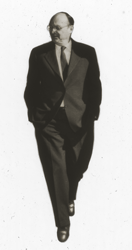 We
did the low temperature thermodynamics and we tried very hard to get
the second order of phase transition — the jump in the specific heat —
and that just didn't come out.... Then I think it was about three weeks
to a month later — I'd been working very hard on it and Bardeen had —
and I remember it was a Wednesday I thought I'd broken the problem. And
I had made a slip of a sign....But I think that. Friday night, a
distinguished Swedish scientist — Berelius, I believe — was visiting
the Bardeens. And so, as I recall — again, my memory may not be
accurate here — that John was somehow off on Cloud 7 that night. And
there were long gaps in the conversation where John was staring into
space, and the conversation was going on, but in a very strange sort of
way. And it was clear that John was thinking hard about something. And
what he was thinking about was how to get the second order phase
transition and exactly how to write the wave function down.
We
did the low temperature thermodynamics and we tried very hard to get
the second order of phase transition — the jump in the specific heat —
and that just didn't come out.... Then I think it was about three weeks
to a month later — I'd been working very hard on it and Bardeen had —
and I remember it was a Wednesday I thought I'd broken the problem. And
I had made a slip of a sign....But I think that. Friday night, a
distinguished Swedish scientist — Berelius, I believe — was visiting
the Bardeens. And so, as I recall — again, my memory may not be
accurate here — that John was somehow off on Cloud 7 that night. And
there were long gaps in the conversation where John was staring into
space, and the conversation was going on, but in a very strange sort of
way. And it was clear that John was thinking hard about something. And
what he was thinking about was how to get the second order phase
transition and exactly how to write the wave function down.
So the next morning — apparently that night he had cracked the problem and called up the next morning. He woke me up early in the morning....and sort of said, "I've got it, I've got it. The whole thing's worked out."
But I had to write the thesis. So I went off to New Hampshire in — what? — the beginning or the middle of March, quietly getting the thing written out.
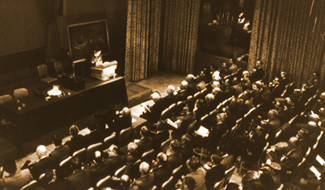 |
| An American Physical Society meeting |
Then came — let's see — then Fred Seitz had called Eli Burstein (who was somehow in charge of, or at least related with, the March meeting of the American Physical Society here in Philadelphia, the solid state physics meeting) and said that a major break in the theory of superconductivity had occurred — or at least John believed so — and was it possible to have two post-deadline papers?
So those were arranged, and John refused himself to come to speak about 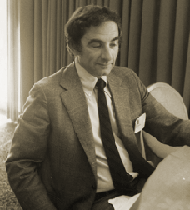 the theory because he wanted to make sure that the young people got the
credit. And, you know, that's unbelievable, fantastic. So Leon was able
to come and I got the word so late that I couldn't get on the plane to
come. So he gave both papers together: he gave the one I was to give and
the one he gave. This was a particularly interesting event not only because
it was announcing the theory fairly early after its inception, if you
like, and in a very raw form. It had only been — what? — a month and
a half old, and the system responded to provide a possibility or a vehicle
to get this out.
the theory because he wanted to make sure that the young people got the
credit. And, you know, that's unbelievable, fantastic. So Leon was able
to come and I got the word so late that I couldn't get on the plane to
come. So he gave both papers together: he gave the one I was to give and
the one he gave. This was a particularly interesting event not only because
it was announcing the theory fairly early after its inception, if you
like, and in a very raw form. It had only been — what? — a month and
a half old, and the system responded to provide a possibility or a vehicle
to get this out.
But much more so, it was to my mind a remarkable insight into the personal
character of John Bardeen, who, I think, in many ways has felt the intrinsic
intellectual contribution he made through superconductivity in some ways
superseded that which was made in the invention of the transistor. He's
said this on various occasions. And yet, for him, after struggling with
the problem with a great amount of success, and having finally come to
the pinnacle of achievement in his professional life, in a sense, steps
aside for two young people — one of whom was a graduate student just
sort of began in the field a year and a half before; the other wasn't
from the field at all but was a post-doc brought in — and says, "OK,
you go out and tell the world and I will stay here in Urbana." It's
just beyond belief.
So, I think, to my mind, that's probably the most exciting message of
the whole thing.
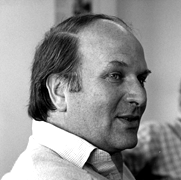 |
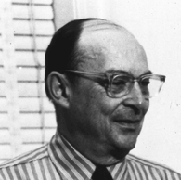 |
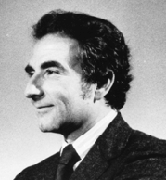 |
